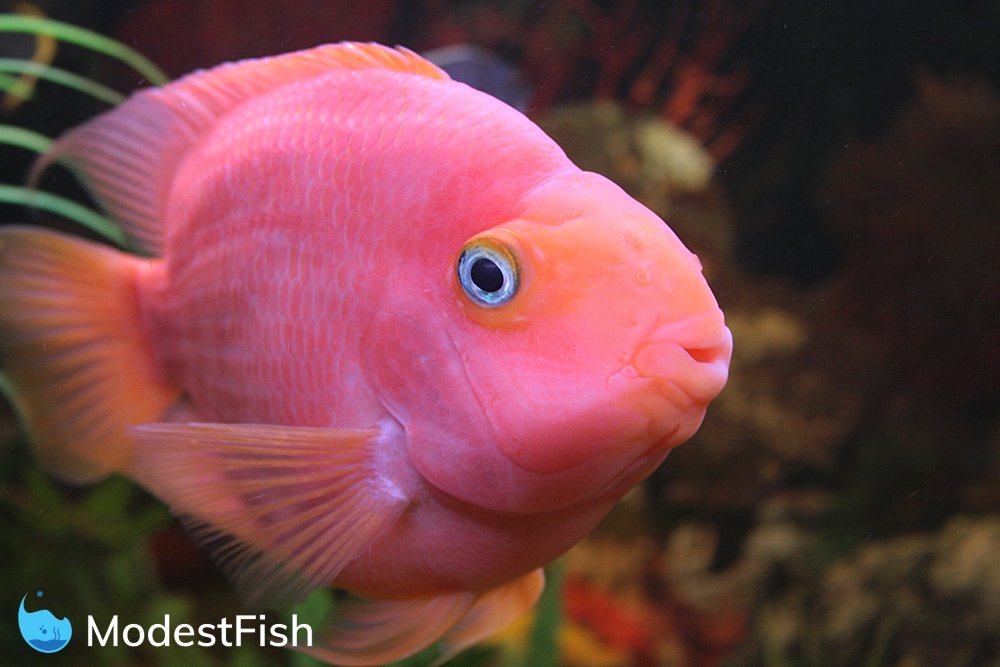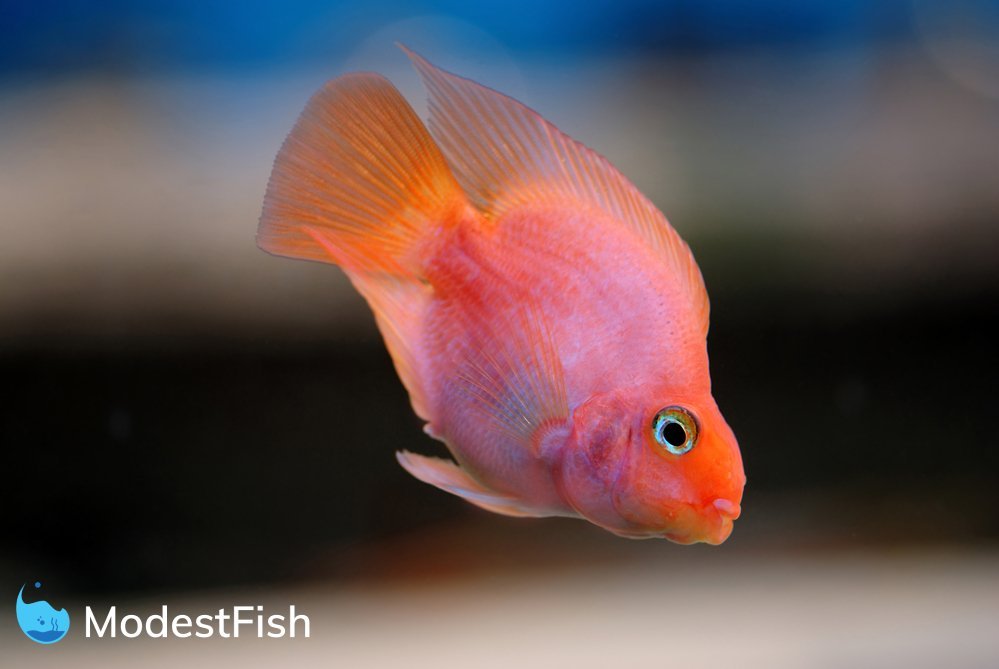Cichlids, you have to love them. With so many verities to pick from the blood parrot is a real peaceful character.
One of my favorites, a real show stopper, you can really build a stunning aquarium around.
In this guide, I’ll teach you how to provide the correct care for Blood Parrot Cichlids so your can live a happy and healthy life.
Blood Parrot Cichlid Care Overview:

- Min. Tank size: 55 gallons (208 liters)
- Temperature: 76°-80°F (24°-27°C)
- Care level: easy
- Diet: omnivore
- Behavior: large, peaceful mid to bottom dweller that can be placed in a community tank
- How many can be kept together: as many as the tank can sustain
- Size: 10 inches (25 centimeters)
Blood Parrot Cichlids in the Wild
Not to be confused with the saltwater bloodparrot, Blood parrot cichlids are man-made hybrids that don’t exist in nature at all and are a part of the cichlidae family.
But, at least we do know that these fish were first bred from two South American cichlid species (probably the midas and redhead cichlids), so that gives us at least a vague idea of how we should set up their tanks and feed them.
Pro Tip: There is a lot of controversy when it comes to this fish. Some people feel that it’s wrong to hybridize fish and they feel that the blood parrot’s mouth is a deformity that is cruel.
I can’t settle this argument, one way or the other, so my focus will be on providing information, not picking a side. Like it or not, this fish is in the aquarium trade and is not going away.
Blood Parrot Cichlid Appearance

How to even describe this fish… they kind of look like you asked a small child to draw you a picture of a fish, and then you magically made it reality.
This is one of the weirdest looking fish in the aquarium trade.
But, I’ll try really hard to explain what it looks like in words.
No promises, though.
Blood parrots have always looked like a cross between a big cichlid and a fancy goldfish to me.
They have bulging heads that curve down from the top to their mouths. In silhouette, this resembles the curve of a parrot’s beak, hence the name.
Their mouths are very unusual. Their bottom lips fold down sharply in the middle and do not match their upper lips. Some blood parrots have difficulty feeding because of this strange shape.
It also means that many of these fish can’t completely close their mouths because of this deformity.
Pro Tip: The odd mouth shape is a result of being a genetic hybrid and is one of the features that make this fish controversial in the aquarium trade.
Seen from the side, blood parrots are disk shaped, like a Discus or severum, with a relatively small tail.
Blood parrots are very heavy bodied fish. They are thickset and very broad. And since they grow to be 8-10 inches (20-25 centimeters) long, this makes them a fairly substantial fish.
They also have large eyes, another thing that makes them look cartoonish. They really are pretty damn adorable and are an obvious favorite with children.
Tank Size For Blood Parrots
Blood parrots can grow up to 10 inches long. And it’s not just the length, they are an extremely thick-bodied fish.
Like any big fish, they put off a lot of waste. For this reason, I really recommend that you keep them in at least a 55 gallon (208 liter) tank, especially if you want to add other fish.
Tank Requirements & Habitat
Heater
You will most definitely need to install an aquarium heater if you keep this species. They need water temperatures of 76°-80°F (24°-27°C).
I always recommend that if you need to choose between two heaters, it’s best to go with the slightly bigger one so it doesn’t have to work hard to hold your tank at the right temperature.
Filtration
Filtration is arguably the most important part of any fish tank. Without it, keeping fish in an aquarium would be impossible.
I’d recommend getting yourself a quality canister filter.
The Aquarium Nitrogen Cycle
Fish constantly put off waste (urine and feces) into the water around them.
I know… eww, but it’s true.
That waste accumulates at the bottom of the aquarium and starts to rot. As it breaks down, it puts off ammonia (NH3).
This is a really bad thing because ammonia is extremely toxic to aquatic life.
Luckily, there are species of beneficial bacteria that live in aquarium filters that help with this problem. One kind eats the ammonia and turns it into something called nitrite (NO2 -1).
Nitrite is also highly toxic, but there is another kind of beneficial bacteria that turns the nitrite into nitrate (NO3-). Nitrate is much less toxic and can be allowed to build up in the water column in between water changes.
This process of ammonia being converted to nitrite and then nitrate is known as the Aquarium Nitrogen Cycle and it’s one of the most important things for any aquarist to understand.
Pro Tip: For a more detailed explanation of the Nitrogen Cycle, please see our article here.
The main takeaway when it comes to blood parrots is that when you have fish this large, you have to make sure that you have a filter with the capacity to handle all of the waste they will produce.
I really don’t think there is such a thing as over filtering a tank when you have big fish. Be sure to go with something that has a large compartment for biomedia, such as a Seachem Tidal 75.
Substrate
Blood parrots will do best with a smooth gravel or sand substrate. They sometimes dig, so it’s best to avoid substrates that are rough and could scratch them up.
Lighting
This species does not have any kind of lighting requirements. So, you’re free to go with whatever lighting you think will look best on your tank.
I recommend LED lighting because it’s the most cost-efficient and you can do the most with it.
Plants and Decor
Blood parrot cichlids like a tank with a mix of open swimming areas as well as large caves where they can hide when they want to retreat.
It’s best to provide several options for hiding places, especially while the fish is still growing. Then they can find a cave that makes them feel secure and has adequate room for them to turn around.
Diet
It’s best to feed blood parrots a varied diet that includes both vegetable based and meaty foods.
It’s especially good to feed them foods rich in carotenoids, like beta carotene, because these will help make them more colorful.
I highly recommend Omega One Super Color Flakes. They’re packed with natural color enhancers and make a great staple diet for your fish.
Related: Best Fish Food For Cichlids Reviewed
Breeding Blood Parrot Cichlids
Getting these fish to breed can be troublesome.
They’ll gladly lay eggs, and diligently guard them, but the eggs rarely result in fry.
That’s because male blood parrot cichlids are mostly infertile. There are some reports of these fish producing young, but these come from Asian fish farmers who inject males with hormones in order to make them fertile.
However, it is quite common for female blood parrots to breed with other South and Central American cichlids, producing new kinds of hybrids.
Personally, I wouldn’t encourage this. We don’t have enough information about whether the fry would be free of defects and able to function normally.
Blood Parrot Cichlid Tank Mates
Despite their large size, this hybrid is a very, very peaceful fish.
You can mix them with any other peaceful, laid back fish that is big enough to not be easily eaten.
Pro Tip: Even the most chill and peaceful fish will eat fish small enough to fit in their mouths.
Some good possible tank mates include:
- Other blood parrot cichlids
- Angelfish
- Boesemani rainbowfish
- Gouramis
- Tiger barbs
- Clown loaches
- Pictus catfish
- Rosy barbs
- Swordtails
- Corydoras catfish
- Bristlenose plecos
Is a Blood Parrot Cichlid Right for You?
This oddball of a fish has a lot of charm. They’re known for recognizing their owners and coming to the front of the tank for love and attention. Some have even been known to enjoy cuddles from their owners.
But, as charming as this hybrid is, it’s important to think about what’s best for the fish when you’re deciding whether or not to get one.
Right off the bat, you’ve got to have a tank large enough to accommodate them. They get pretty darn huge, so you’ve got to have at least a 55 gallon tank (of course, bigger is always better when it comes to fish tanks).
They’re also very peaceful. So it’s not a good idea to mix them with semi-aggressive/aggressive fish. The poor blood parrots would just get beaten to death.
At the same time, it’s not a good idea to mix them with tiny nano fish that they can easily swallow.
They’ll do well in a tank by themselves, with other blood parrots or with big peaceful community fish.
These are super cute fish with great personalities. They’re perfect if you want a big centerpiece fish but don’t want to worry about hyper aggression.
I hope all of this information is helpful.
I wish you and your fish the very best.
